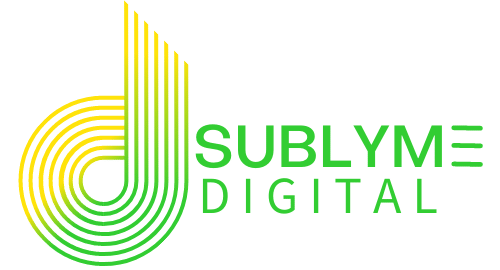
Author: Graham Davidson
Graham Davidson is the Owner and Chief Marketing Guru of Sublyme Digital, leading the agency’s remote-first approach to deliver impactful web design, SEO, and digital growth strategies for businesses across North America.
How AI Is Revolutionizing Content Marketing in 2025
The Age of Personalization
Key Takeaways:
- Personalized content is now essential for digital marketing success.
- AI enables deep customer insights and hyper-targeted experiences.
- Marketers can use AI tools for content creation, optimization, and delivery.
- Real-world case studies show measurable ROI from AI-powered personalization.
- Overcoming challenges and ethical considerations is key for sustainable growth.
Why Personalization Matters More Than Ever
The Decline of Generic Content
Let’s rewind a decade. Back then, blasting the same newsletter to your entire list worked—sort of. But as inboxes filled up, open rates dropped and unsubscribe rates soared. Customers grew tired of irrelevant messaging. The cost? Lost trust, lower engagement, and missed opportunities.
Fast-forward to today. According to a 2024 Salesforce study, 76% of consumers expect companies to understand their needs and expectations. Meanwhile, 80% are more likely to do business with brands that offer personalized experiences. Personalization isn’t just a “nice-to-have”—it’s a competitive necessity.
The Psychology Behind Personalization
Personalized content taps into basic human psychology. We pay attention to things that are relevant to us. When a brand remembers our preferences, anticipates our needs, or recommends something that feels “just right,” it builds a sense of connection. This emotional resonance drives action—whether it’s a click, a purchase, or a share.
The Business Impact
- Personalized emails deliver 6x higher transaction rates (Experian).
- Marketers see an average 20% increase in sales when using personalized experiences (Monetate).
- 80% of consumers are more likely to buy from a company that provides tailored experiences (Epsilon).
In short: Personalization isn’t just a buzzword—it’s a proven driver of business growth.
How AI Powers Next-Level Personalization
Understanding AI in Content Marketing
Artificial Intelligence refers to computer systems that can perform tasks typically requiring human intelligence—like learning, reasoning, problem-solving, and decision-making. In content marketing, AI excels at processing and analyzing data at a scale and speed that humans simply can’t match.
Key Types of Data AI Uses
- Demographic Data: Age, gender, location, job title, income, etc.
- Behavioral Data: Website visits, clicks, downloads, purchase history, social media engagement.
- Psychographic Data: Interests, values, attitudes, motivations, lifestyle choices.
- Contextual Data: Device type, time of day, weather, location at the moment of engagement.
The AI Personalization Process: Step by Step
- Data Collection: AI gathers data from website analytics, CRM systems, social media, email platforms, and more.
- Pattern Recognition: Machine learning algorithms analyze the data to identify patterns, trends, and correlations.
- Segmentation: AI segments your audience into groups based on shared characteristics or behaviors.
- Content Matching: AI matches content assets (blogs, products, emails, ads) to each segment or individual.
- Real-Time Optimization: AI continuously tests and refines content delivery based on performance data.
Real-World Example: Netflix
Practical Applications—AI in Action
1. Dynamic Website Content
2. Hyper-Personalized Email Campaigns
3. AI-Driven Content Recommendations
4. Personalized Social Media Experiences
5. Chatbots and Conversational AI
6. Personalized Product Recommendations
AI enables marketers to analyze massive datasets, uncover hidden patterns, and deliver the right message to the right person at exactly the right time.

Tools of the Trade—AI Platforms
Building a Personalized Content Strategy with AI
Overcoming Challenges in AI Personalization
FAQs:
Answer: AI personalizes content marketing by analyzing customer data—such as demographics, behavior, and interests—to deliver tailored content, recommendations, and experiences across various channels. This ensures each user receives information relevant to their unique needs and preferences.
Answer: Benefits include higher engagement rates, improved conversion rates, stronger customer loyalty, and more efficient marketing spend. AI-driven personalization helps brands connect with audiences on a deeper level and achieve better business outcomes.
Answer: Popular tools include Jasper and Copy.ai for AI copywriting, MarketMuse and Surfer SEO for content optimization, and personalization platforms like Adobe Experience Cloud and HubSpot. These tools help marketers create, optimize, and deliver personalized experiences at scale.
Answer: Yes, when brands are transparent about data use, obtain explicit consent, and comply with privacy regulations such as GDPR and CCPA. Ethical AI personalization prioritizes user privacy and gives customers control over their data and preferences.
Success Stories
365 Data Centers
Discover how we rapidly rebuilt and optimized a 30-page website for 365 Data Centers, restoring their online presence and managing digital ad campaigns across key regions to drive engagement and growth.
XTECH Football Pads
Discover how we transformed XTECH Football Pads‘ digital presence, boosting their online sales and tripling website traffic through innovative website development and user experience enhancements.
BeEarth Foundation
Discover how we partnered with the BeEarth Foundation to develop a website that aligns with their mission of sustainability and global engagement. Our work has significantly increased their online visibility and engagement, supporting their efforts to promote sustainable development.
We Recycle Solar
Learn how we illuminated digital success for We Recycle Solar by completely redesigning their website to reflect their leadership in the growing solar recycling industry and implementing strategic digital advertising campaigns that enhanced their visibility at key industry events.
Preferred Home Health Care & Nursing Services
Explore how we elevated the digital presence of Preferred Home Health Care & Nursing Services by enhancing their website for better lead generation, building a dedicated site for staff recognition, and optimizing SEO for their location pages.
What Our Clients Say: Elevating Online Success
We Build Cool
The Future of AI-Powered Personalization
The evolution of AI-driven personalization is accelerating, and the next wave of innovation promises to make digital experiences even smarter, more seamless, and more human. Here’s a look at the major trends shaping the future—and how brands can prepare to thrive in this new era.
Voice Search and Conversational AI
AI is at the heart of this transformation. Advanced natural language processing (NLP) algorithms can interpret context, intent, and even subtle nuances in speech, enabling brands to provide answers that feel genuinely helpful. For marketers, this means rethinking content creation: focusing on long-tail, question-based keywords, crafting concise answers, and structuring information so it’s easily accessible by voice search engines.
But conversational AI isn’t limited to search. Chatbots and virtual assistants are evolving into true digital concierges, capable of handling complex queries, providing personalized recommendations, and even completing transactions—all through natural dialogue. The brands that win in this space will be those that invest in understanding their audience’s spoken language, anticipate their needs, and design experiences that feel frictionless, intuitive, and human.
Predictive Personalization
The next frontier of personalization is not just responding to user behavior, but anticipating it. Predictive personalization uses AI to forecast what users will want, need, or do next—often before they even realize it themselves.
Imagine a retail site that knows when you’re likely to need a refill of a favorite product, or a news app that serves you stories on emerging topics just as your interest begins to spike. Predictive personalization transforms marketing from reactive to anticipatory, delighting customers with experiences that feel almost magical in their relevance.
For brands, this means deeper loyalty, higher conversion rates, and a competitive edge that’s hard to replicate. The key is to balance automation with transparency—letting users know why they’re seeing certain content, and giving them control to adjust recommendations as needed.
Multichannel Personalization
Consumers today don’t think in terms of “channels”—they expect a unified, consistent experience whether they’re browsing a website, scrolling social media, opening an email, or visiting a physical store. The future of personalization is omnichannel, and AI is the engine that makes it possible.
AI-powered platforms can now track and integrate user data across all touchpoints, building a holistic view of each customer’s journey. This enables brands to synchronize messaging, offers, and experiences in real time. For example, a customer who browses a product on mobile might receive a personalized follow-up email, see a relevant ad on social media, and be greeted with a tailored offer if they visit the store—all reflecting their most recent interactions and preferences.
Achieving true multichannel personalization requires breaking down data silos, investing in robust integrations, and designing content that adapts fluidly to different contexts and devices. The payoff is a seamless, frictionless experience that builds trust and drives engagement at every stage.
Human + AI: The Perfect Partnership
Despite all the technological advances, the most powerful marketing will always be a blend of machine intelligence and human creativity. AI excels at analyzing data, identifying patterns, and automating repetitive tasks—but it’s humans who bring empathy, nuance, and storytelling to the table.
Final Thoughts: Embrace the AI-Powered Personalization Revolution
Let's Build Something Sublyme
Ready to transform your content marketing?
Start exploring AI-powered personalization tools today and see how tailored experiences can drive engagement, loyalty, and growth for your brand. Need help getting started? Contact Sublyme Digital—we’ll help you unlock the full potential of AI for your business.



